ICT705 Data and System Integration Report: ATMC Semester 1, 2018
VerifiedAdded on 2021/04/21
|17
|4581
|36
Report
AI Summary
This report focuses on data and system integration within the context of Health Information Technology (HIT). It explores the application of data mining and data warehousing to enhance the efficiency and accuracy of healthcare decision-making processes, particularly in line with the Health Information Technology for Economic and Clinical Health (HITECH) Act. The report details the use of various technologies to promote health and information technology, including the development of three key architecture diagrams: an architecture overview, a logical view based on EIA RA, and a component interaction diagram. The primary objective is to establish a system capable of maintaining and integrating patient health records across different healthcare providers. The report delves into internal and external applications, information management components, data integration strategies, application programs, cloud services, and security and privacy measures, providing a comprehensive analysis of the system's architecture and functionality. Furthermore, it covers enterprise information integration services, information management and integration challenges, and offers recommendations for future development.
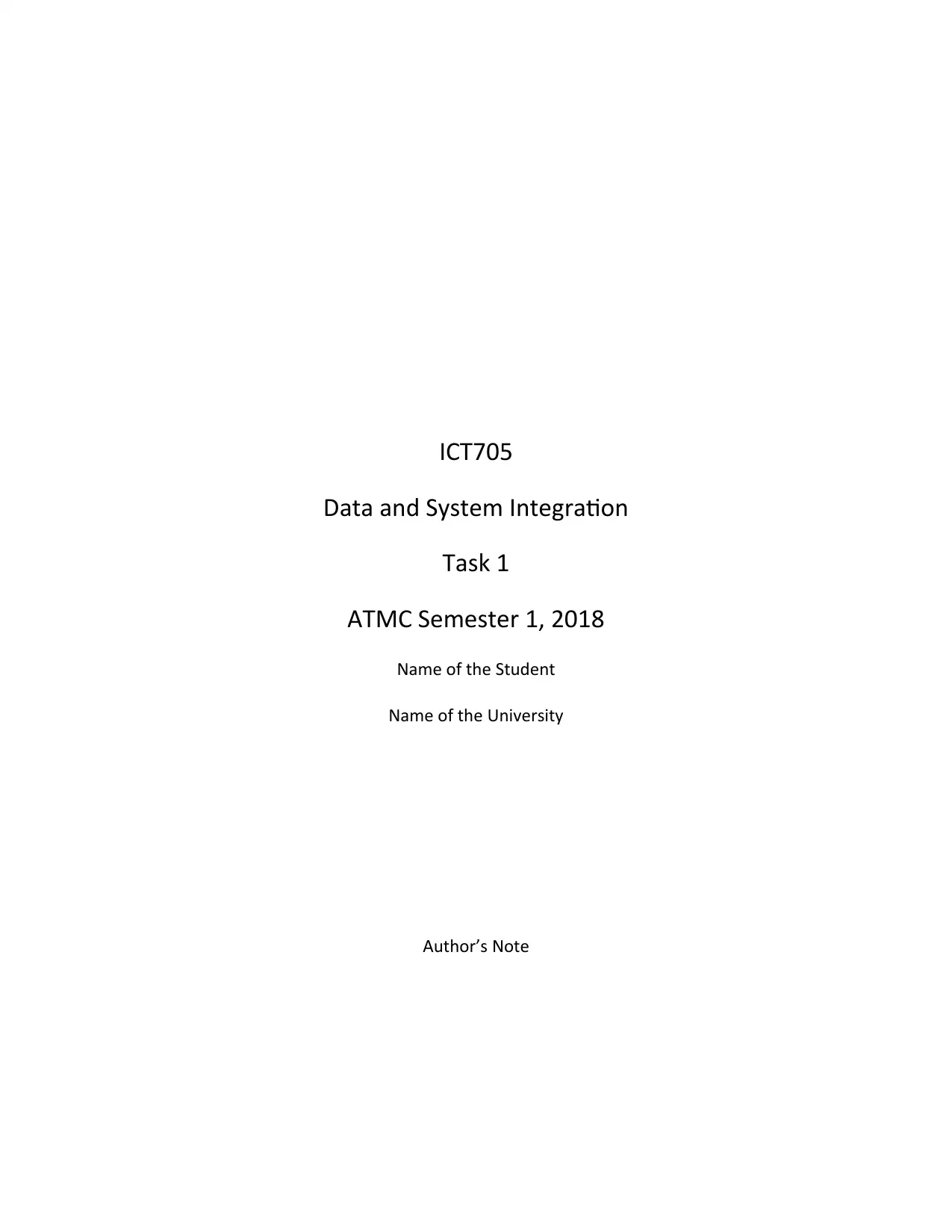
ICT705
Data and System Integration
Task 1
ATMC Semester 1, 2018
Name of the Student
Name of the University
Author’s Note
Data and System Integration
Task 1
ATMC Semester 1, 2018
Name of the Student
Name of the University
Author’s Note
Paraphrase This Document
Need a fresh take? Get an instant paraphrase of this document with our AI Paraphraser
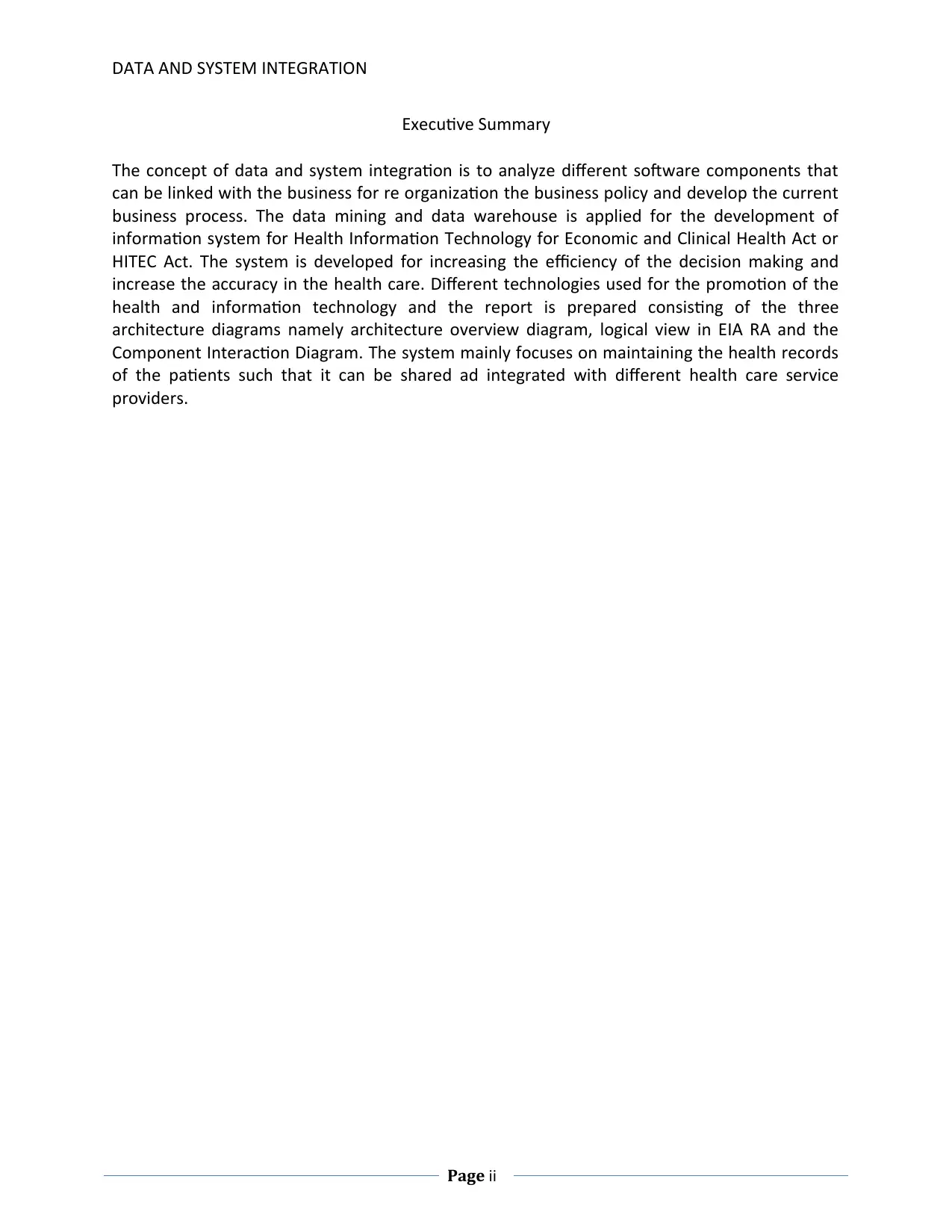
DATA AND SYSTEM INTEGRATION
Executive Summary
The concept of data and system integration is to analyze different software components that
can be linked with the business for re organization the business policy and develop the current
business process. The data mining and data warehouse is applied for the development of
information system for Health Information Technology for Economic and Clinical Health Act or
HITEC Act. The system is developed for increasing the efficiency of the decision making and
increase the accuracy in the health care. Different technologies used for the promotion of the
health and information technology and the report is prepared consisting of the three
architecture diagrams namely architecture overview diagram, logical view in EIA RA and the
Component Interaction Diagram. The system mainly focuses on maintaining the health records
of the patients such that it can be shared ad integrated with different health care service
providers.
Page ii
Executive Summary
The concept of data and system integration is to analyze different software components that
can be linked with the business for re organization the business policy and develop the current
business process. The data mining and data warehouse is applied for the development of
information system for Health Information Technology for Economic and Clinical Health Act or
HITEC Act. The system is developed for increasing the efficiency of the decision making and
increase the accuracy in the health care. Different technologies used for the promotion of the
health and information technology and the report is prepared consisting of the three
architecture diagrams namely architecture overview diagram, logical view in EIA RA and the
Component Interaction Diagram. The system mainly focuses on maintaining the health records
of the patients such that it can be shared ad integrated with different health care service
providers.
Page ii
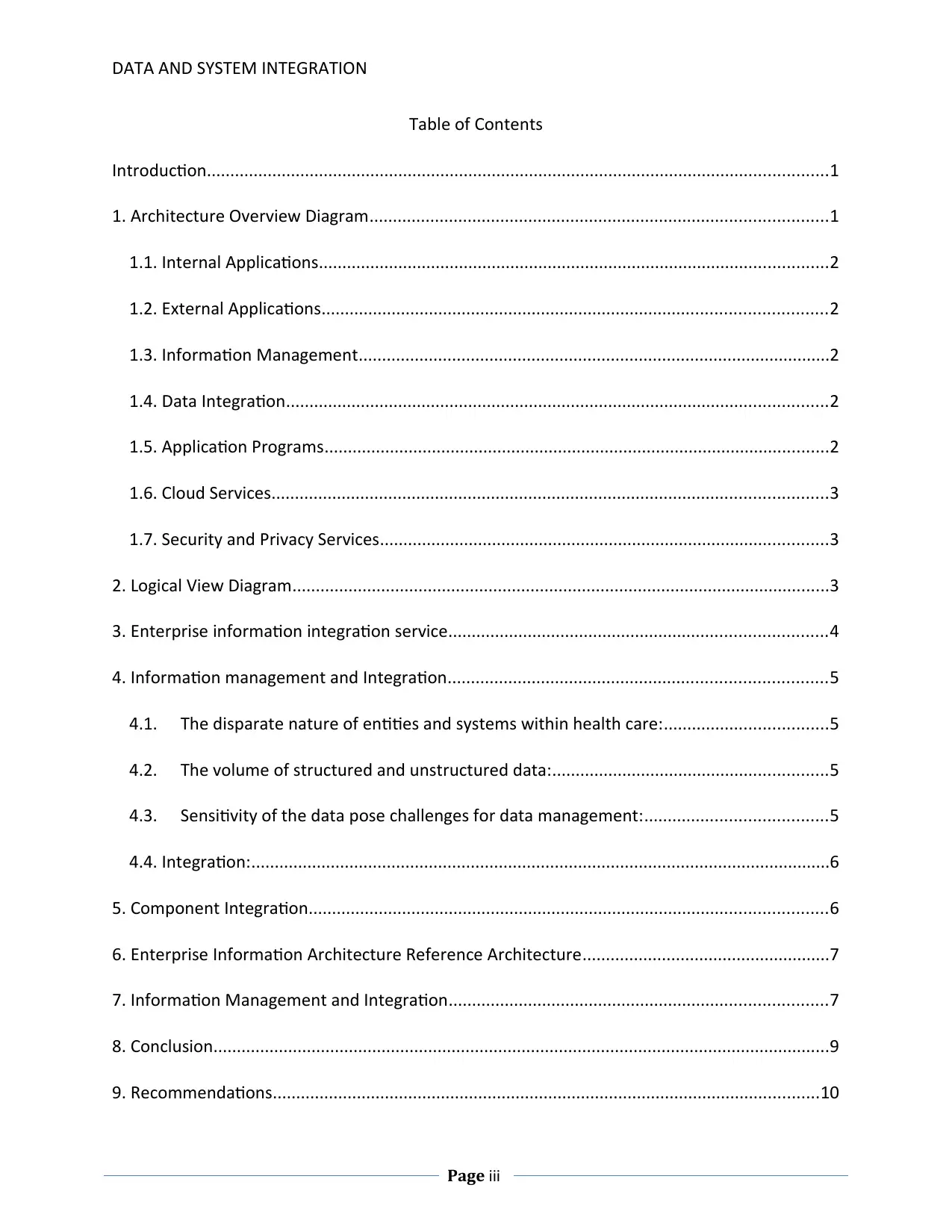
DATA AND SYSTEM INTEGRATION
Table of Contents
Introduction.....................................................................................................................................1
1. Architecture Overview Diagram..................................................................................................1
1.1. Internal Applications.............................................................................................................2
1.2. External Applications............................................................................................................2
1.3. Information Management.....................................................................................................2
1.4. Data Integration....................................................................................................................2
1.5. Application Programs............................................................................................................2
1.6. Cloud Services.......................................................................................................................3
1.7. Security and Privacy Services................................................................................................3
2. Logical View Diagram...................................................................................................................3
3. Enterprise information integration service.................................................................................4
4. Information management and Integration.................................................................................5
4.1. The disparate nature of entities and systems within health care:...................................5
4.2. The volume of structured and unstructured data:...........................................................5
4.3. Sensitivity of the data pose challenges for data management:.......................................5
4.4. Integration:............................................................................................................................6
5. Component Integration...............................................................................................................6
6. Enterprise Information Architecture Reference Architecture.....................................................7
7. Information Management and Integration.................................................................................7
8. Conclusion....................................................................................................................................9
9. Recommendations.....................................................................................................................10
Page iii
Table of Contents
Introduction.....................................................................................................................................1
1. Architecture Overview Diagram..................................................................................................1
1.1. Internal Applications.............................................................................................................2
1.2. External Applications............................................................................................................2
1.3. Information Management.....................................................................................................2
1.4. Data Integration....................................................................................................................2
1.5. Application Programs............................................................................................................2
1.6. Cloud Services.......................................................................................................................3
1.7. Security and Privacy Services................................................................................................3
2. Logical View Diagram...................................................................................................................3
3. Enterprise information integration service.................................................................................4
4. Information management and Integration.................................................................................5
4.1. The disparate nature of entities and systems within health care:...................................5
4.2. The volume of structured and unstructured data:...........................................................5
4.3. Sensitivity of the data pose challenges for data management:.......................................5
4.4. Integration:............................................................................................................................6
5. Component Integration...............................................................................................................6
6. Enterprise Information Architecture Reference Architecture.....................................................7
7. Information Management and Integration.................................................................................7
8. Conclusion....................................................................................................................................9
9. Recommendations.....................................................................................................................10
Page iii
⊘ This is a preview!⊘
Do you want full access?
Subscribe today to unlock all pages.

Trusted by 1+ million students worldwide

DATA AND SYSTEM INTEGRATION
Bibliography...................................................................................................................................11
Page iv
Bibliography...................................................................................................................................11
Page iv
Paraphrase This Document
Need a fresh take? Get an instant paraphrase of this document with our AI Paraphraser
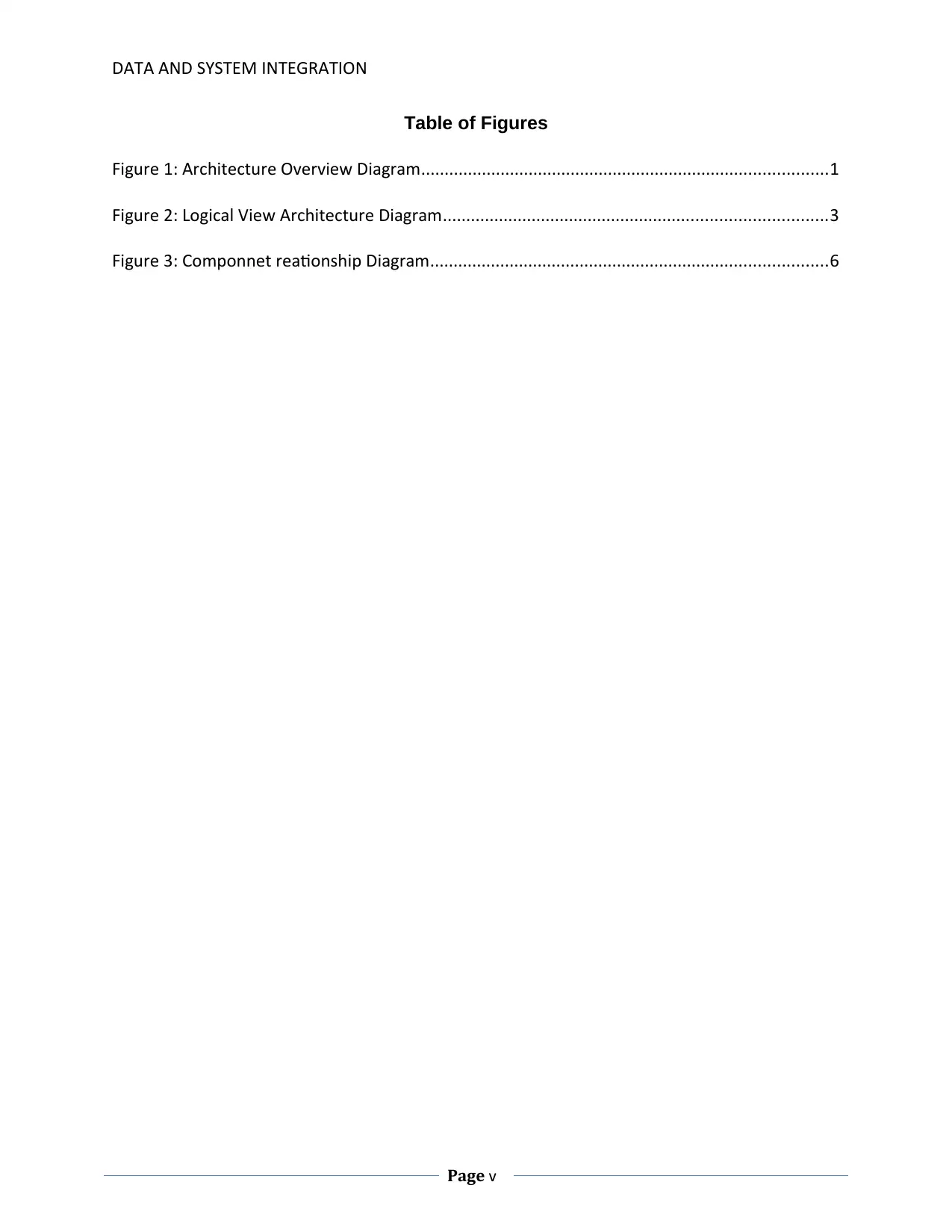
DATA AND SYSTEM INTEGRATION
Table of Figures
Figure 1: Architecture Overview Diagram.......................................................................................1
Figure 2: Logical View Architecture Diagram..................................................................................3
Figure 3: Componnet reationship Diagram.....................................................................................6
Page v
Table of Figures
Figure 1: Architecture Overview Diagram.......................................................................................1
Figure 2: Logical View Architecture Diagram..................................................................................3
Figure 3: Componnet reationship Diagram.....................................................................................6
Page v
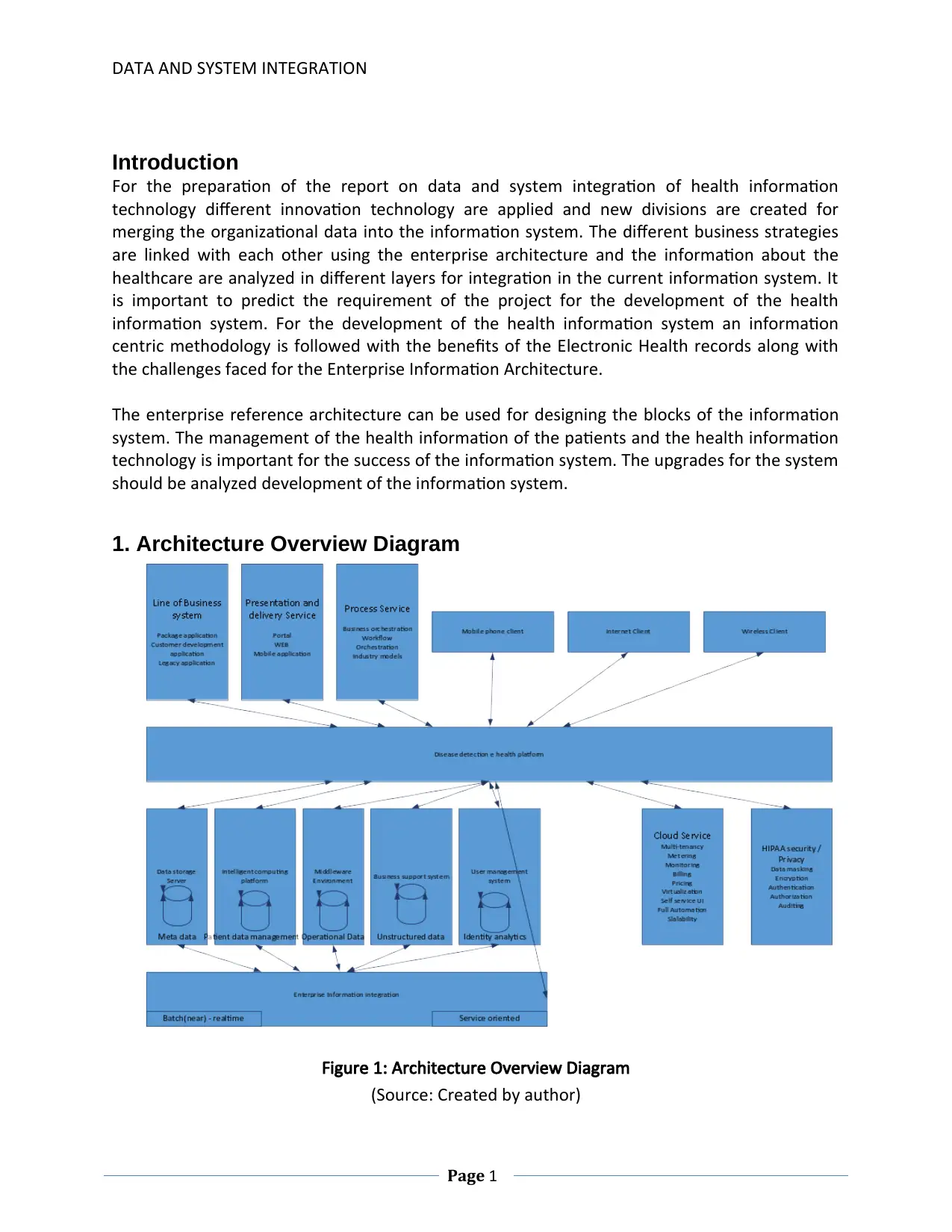
DATA AND SYSTEM INTEGRATION
Introduction
For the preparation of the report on data and system integration of health information
technology different innovation technology are applied and new divisions are created for
merging the organizational data into the information system. The different business strategies
are linked with each other using the enterprise architecture and the information about the
healthcare are analyzed in different layers for integration in the current information system. It
is important to predict the requirement of the project for the development of the health
information system. For the development of the health information system an information
centric methodology is followed with the benefits of the Electronic Health records along with
the challenges faced for the Enterprise Information Architecture.
The enterprise reference architecture can be used for designing the blocks of the information
system. The management of the health information of the patients and the health information
technology is important for the success of the information system. The upgrades for the system
should be analyzed development of the information system.
1. Architecture Overview Diagram
Figure 1: Architecture Overview Diagram
(Source: Created by author)
Page 1
Introduction
For the preparation of the report on data and system integration of health information
technology different innovation technology are applied and new divisions are created for
merging the organizational data into the information system. The different business strategies
are linked with each other using the enterprise architecture and the information about the
healthcare are analyzed in different layers for integration in the current information system. It
is important to predict the requirement of the project for the development of the health
information system. For the development of the health information system an information
centric methodology is followed with the benefits of the Electronic Health records along with
the challenges faced for the Enterprise Information Architecture.
The enterprise reference architecture can be used for designing the blocks of the information
system. The management of the health information of the patients and the health information
technology is important for the success of the information system. The upgrades for the system
should be analyzed development of the information system.
1. Architecture Overview Diagram
Figure 1: Architecture Overview Diagram
(Source: Created by author)
Page 1
⊘ This is a preview!⊘
Do you want full access?
Subscribe today to unlock all pages.

Trusted by 1+ million students worldwide
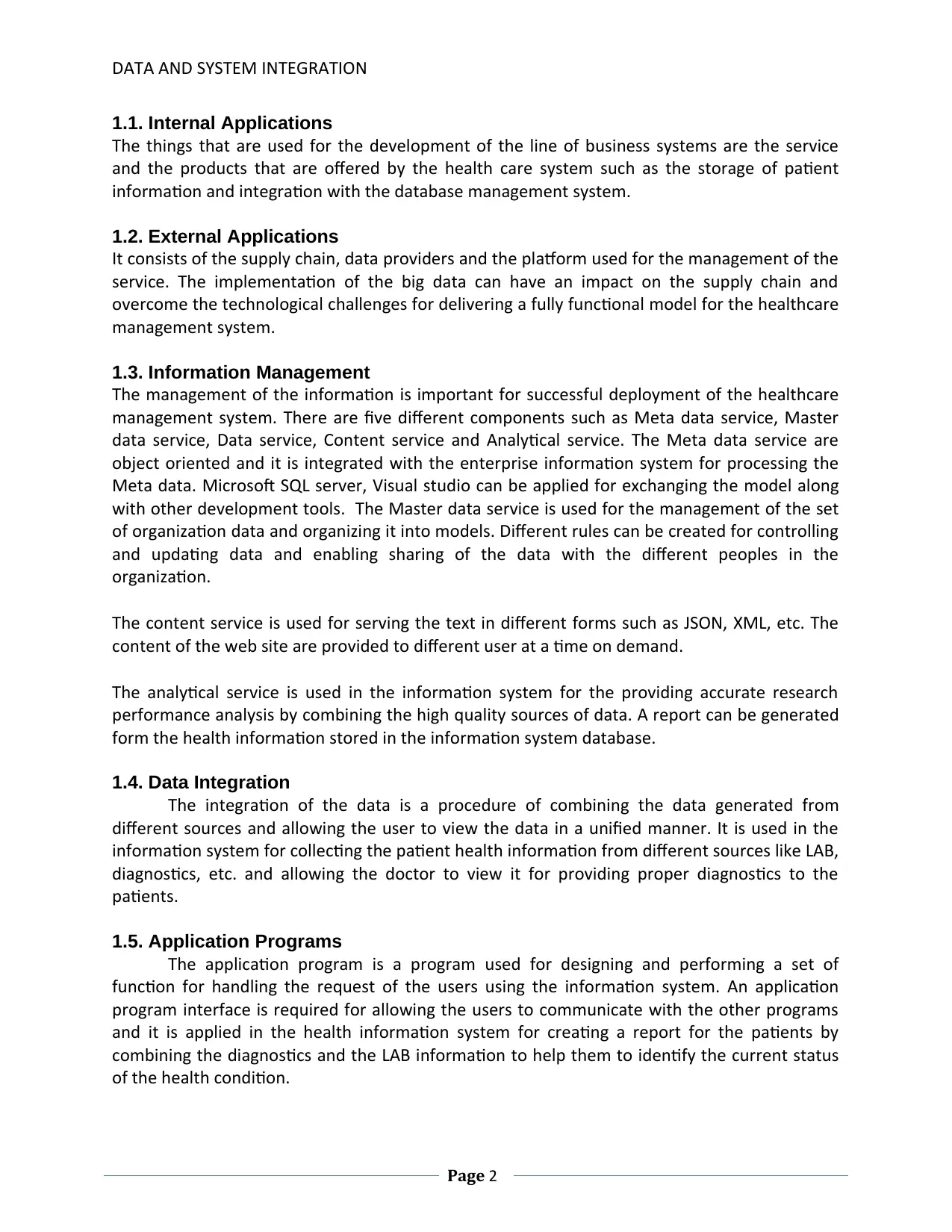
DATA AND SYSTEM INTEGRATION
1.1. Internal Applications
The things that are used for the development of the line of business systems are the service
and the products that are offered by the health care system such as the storage of patient
information and integration with the database management system.
1.2. External Applications
It consists of the supply chain, data providers and the platform used for the management of the
service. The implementation of the big data can have an impact on the supply chain and
overcome the technological challenges for delivering a fully functional model for the healthcare
management system.
1.3. Information Management
The management of the information is important for successful deployment of the healthcare
management system. There are five different components such as Meta data service, Master
data service, Data service, Content service and Analytical service. The Meta data service are
object oriented and it is integrated with the enterprise information system for processing the
Meta data. Microsoft SQL server, Visual studio can be applied for exchanging the model along
with other development tools. The Master data service is used for the management of the set
of organization data and organizing it into models. Different rules can be created for controlling
and updating data and enabling sharing of the data with the different peoples in the
organization.
The content service is used for serving the text in different forms such as JSON, XML, etc. The
content of the web site are provided to different user at a time on demand.
The analytical service is used in the information system for the providing accurate research
performance analysis by combining the high quality sources of data. A report can be generated
form the health information stored in the information system database.
1.4. Data Integration
The integration of the data is a procedure of combining the data generated from
different sources and allowing the user to view the data in a unified manner. It is used in the
information system for collecting the patient health information from different sources like LAB,
diagnostics, etc. and allowing the doctor to view it for providing proper diagnostics to the
patients.
1.5. Application Programs
The application program is a program used for designing and performing a set of
function for handling the request of the users using the information system. An application
program interface is required for allowing the users to communicate with the other programs
and it is applied in the health information system for creating a report for the patients by
combining the diagnostics and the LAB information to help them to identify the current status
of the health condition.
Page 2
1.1. Internal Applications
The things that are used for the development of the line of business systems are the service
and the products that are offered by the health care system such as the storage of patient
information and integration with the database management system.
1.2. External Applications
It consists of the supply chain, data providers and the platform used for the management of the
service. The implementation of the big data can have an impact on the supply chain and
overcome the technological challenges for delivering a fully functional model for the healthcare
management system.
1.3. Information Management
The management of the information is important for successful deployment of the healthcare
management system. There are five different components such as Meta data service, Master
data service, Data service, Content service and Analytical service. The Meta data service are
object oriented and it is integrated with the enterprise information system for processing the
Meta data. Microsoft SQL server, Visual studio can be applied for exchanging the model along
with other development tools. The Master data service is used for the management of the set
of organization data and organizing it into models. Different rules can be created for controlling
and updating data and enabling sharing of the data with the different peoples in the
organization.
The content service is used for serving the text in different forms such as JSON, XML, etc. The
content of the web site are provided to different user at a time on demand.
The analytical service is used in the information system for the providing accurate research
performance analysis by combining the high quality sources of data. A report can be generated
form the health information stored in the information system database.
1.4. Data Integration
The integration of the data is a procedure of combining the data generated from
different sources and allowing the user to view the data in a unified manner. It is used in the
information system for collecting the patient health information from different sources like LAB,
diagnostics, etc. and allowing the doctor to view it for providing proper diagnostics to the
patients.
1.5. Application Programs
The application program is a program used for designing and performing a set of
function for handling the request of the users using the information system. An application
program interface is required for allowing the users to communicate with the other programs
and it is applied in the health information system for creating a report for the patients by
combining the diagnostics and the LAB information to help them to identify the current status
of the health condition.
Page 2
Paraphrase This Document
Need a fresh take? Get an instant paraphrase of this document with our AI Paraphraser
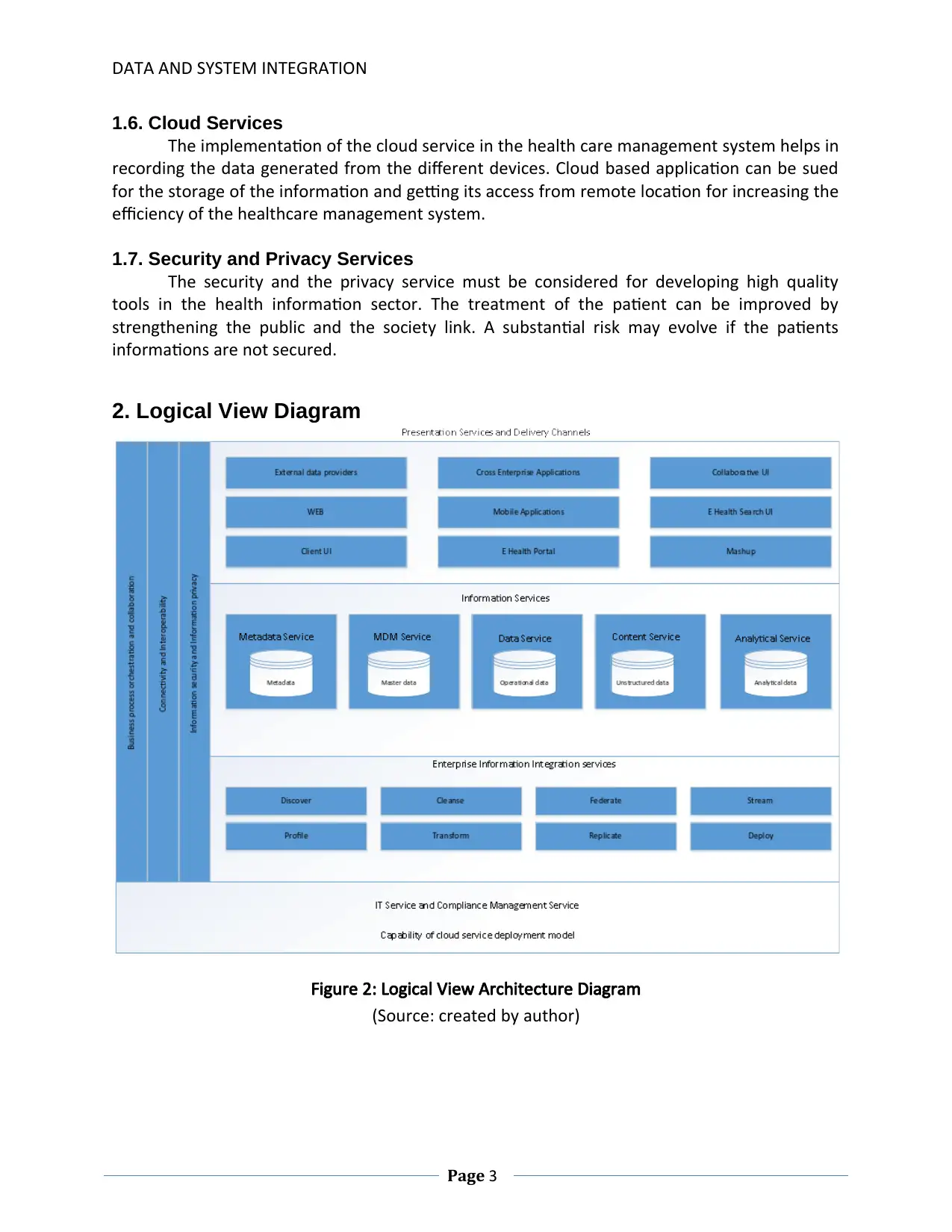
DATA AND SYSTEM INTEGRATION
1.6. Cloud Services
The implementation of the cloud service in the health care management system helps in
recording the data generated from the different devices. Cloud based application can be sued
for the storage of the information and getting its access from remote location for increasing the
efficiency of the healthcare management system.
1.7. Security and Privacy Services
The security and the privacy service must be considered for developing high quality
tools in the health information sector. The treatment of the patient can be improved by
strengthening the public and the society link. A substantial risk may evolve if the patients
informations are not secured.
2. Logical View Diagram
Figure 2: Logical View Architecture Diagram
(Source: created by author)
Page 3
1.6. Cloud Services
The implementation of the cloud service in the health care management system helps in
recording the data generated from the different devices. Cloud based application can be sued
for the storage of the information and getting its access from remote location for increasing the
efficiency of the healthcare management system.
1.7. Security and Privacy Services
The security and the privacy service must be considered for developing high quality
tools in the health information sector. The treatment of the patient can be improved by
strengthening the public and the society link. A substantial risk may evolve if the patients
informations are not secured.
2. Logical View Diagram
Figure 2: Logical View Architecture Diagram
(Source: created by author)
Page 3
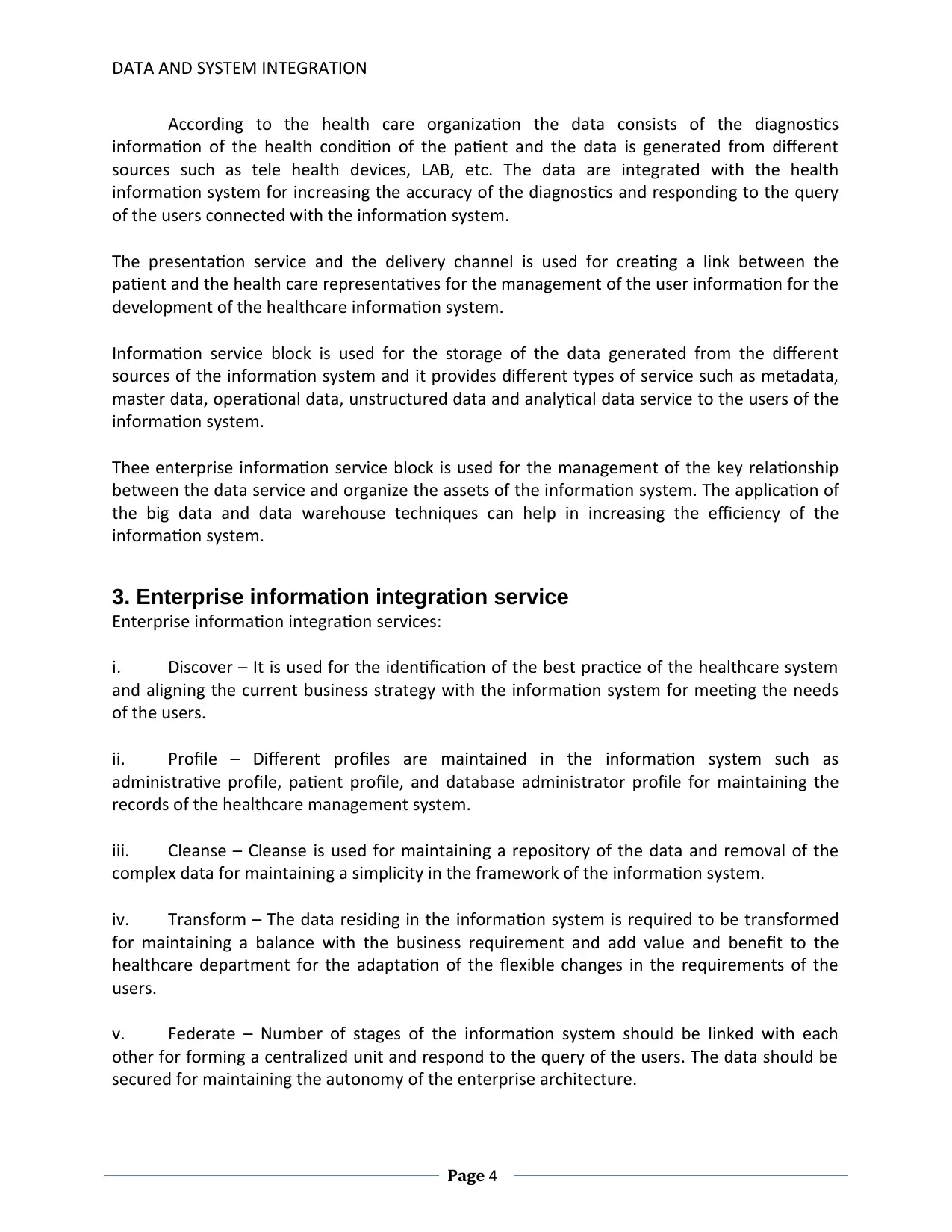
DATA AND SYSTEM INTEGRATION
According to the health care organization the data consists of the diagnostics
information of the health condition of the patient and the data is generated from different
sources such as tele health devices, LAB, etc. The data are integrated with the health
information system for increasing the accuracy of the diagnostics and responding to the query
of the users connected with the information system.
The presentation service and the delivery channel is used for creating a link between the
patient and the health care representatives for the management of the user information for the
development of the healthcare information system.
Information service block is used for the storage of the data generated from the different
sources of the information system and it provides different types of service such as metadata,
master data, operational data, unstructured data and analytical data service to the users of the
information system.
Thee enterprise information service block is used for the management of the key relationship
between the data service and organize the assets of the information system. The application of
the big data and data warehouse techniques can help in increasing the efficiency of the
information system.
3. Enterprise information integration service
Enterprise information integration services:
i. Discover – It is used for the identification of the best practice of the healthcare system
and aligning the current business strategy with the information system for meeting the needs
of the users.
ii. Profile – Different profiles are maintained in the information system such as
administrative profile, patient profile, and database administrator profile for maintaining the
records of the healthcare management system.
iii. Cleanse – Cleanse is used for maintaining a repository of the data and removal of the
complex data for maintaining a simplicity in the framework of the information system.
iv. Transform – The data residing in the information system is required to be transformed
for maintaining a balance with the business requirement and add value and benefit to the
healthcare department for the adaptation of the flexible changes in the requirements of the
users.
v. Federate – Number of stages of the information system should be linked with each
other for forming a centralized unit and respond to the query of the users. The data should be
secured for maintaining the autonomy of the enterprise architecture.
Page 4
According to the health care organization the data consists of the diagnostics
information of the health condition of the patient and the data is generated from different
sources such as tele health devices, LAB, etc. The data are integrated with the health
information system for increasing the accuracy of the diagnostics and responding to the query
of the users connected with the information system.
The presentation service and the delivery channel is used for creating a link between the
patient and the health care representatives for the management of the user information for the
development of the healthcare information system.
Information service block is used for the storage of the data generated from the different
sources of the information system and it provides different types of service such as metadata,
master data, operational data, unstructured data and analytical data service to the users of the
information system.
Thee enterprise information service block is used for the management of the key relationship
between the data service and organize the assets of the information system. The application of
the big data and data warehouse techniques can help in increasing the efficiency of the
information system.
3. Enterprise information integration service
Enterprise information integration services:
i. Discover – It is used for the identification of the best practice of the healthcare system
and aligning the current business strategy with the information system for meeting the needs
of the users.
ii. Profile – Different profiles are maintained in the information system such as
administrative profile, patient profile, and database administrator profile for maintaining the
records of the healthcare management system.
iii. Cleanse – Cleanse is used for maintaining a repository of the data and removal of the
complex data for maintaining a simplicity in the framework of the information system.
iv. Transform – The data residing in the information system is required to be transformed
for maintaining a balance with the business requirement and add value and benefit to the
healthcare department for the adaptation of the flexible changes in the requirements of the
users.
v. Federate – Number of stages of the information system should be linked with each
other for forming a centralized unit and respond to the query of the users. The data should be
secured for maintaining the autonomy of the enterprise architecture.
Page 4
⊘ This is a preview!⊘
Do you want full access?
Subscribe today to unlock all pages.

Trusted by 1+ million students worldwide
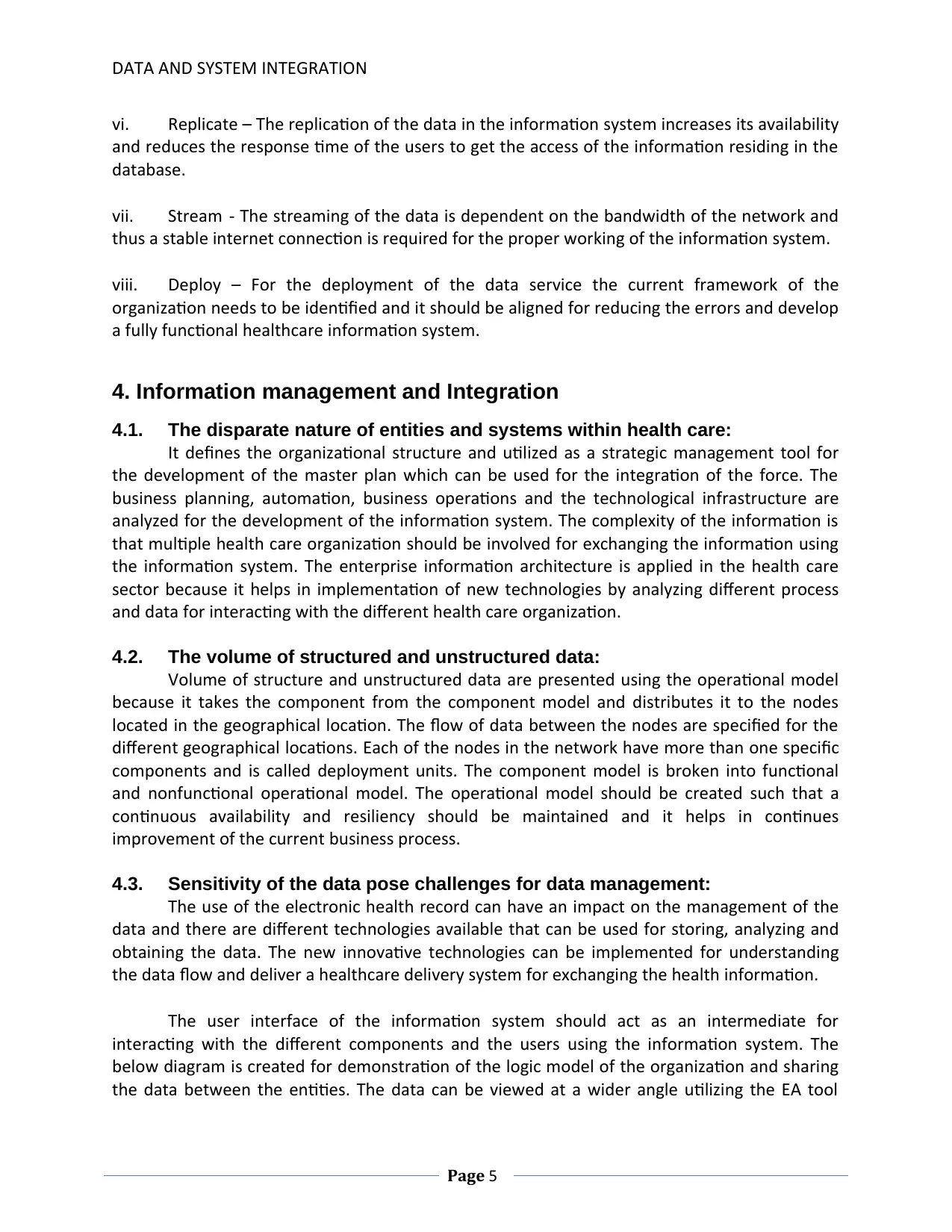
DATA AND SYSTEM INTEGRATION
vi. Replicate – The replication of the data in the information system increases its availability
and reduces the response time of the users to get the access of the information residing in the
database.
vii. Stream - The streaming of the data is dependent on the bandwidth of the network and
thus a stable internet connection is required for the proper working of the information system.
viii. Deploy – For the deployment of the data service the current framework of the
organization needs to be identified and it should be aligned for reducing the errors and develop
a fully functional healthcare information system.
4. Information management and Integration
4.1. The disparate nature of entities and systems within health care:
It defines the organizational structure and utilized as a strategic management tool for
the development of the master plan which can be used for the integration of the force. The
business planning, automation, business operations and the technological infrastructure are
analyzed for the development of the information system. The complexity of the information is
that multiple health care organization should be involved for exchanging the information using
the information system. The enterprise information architecture is applied in the health care
sector because it helps in implementation of new technologies by analyzing different process
and data for interacting with the different health care organization.
4.2. The volume of structured and unstructured data:
Volume of structure and unstructured data are presented using the operational model
because it takes the component from the component model and distributes it to the nodes
located in the geographical location. The flow of data between the nodes are specified for the
different geographical locations. Each of the nodes in the network have more than one specific
components and is called deployment units. The component model is broken into functional
and nonfunctional operational model. The operational model should be created such that a
continuous availability and resiliency should be maintained and it helps in continues
improvement of the current business process.
4.3. Sensitivity of the data pose challenges for data management:
The use of the electronic health record can have an impact on the management of the
data and there are different technologies available that can be used for storing, analyzing and
obtaining the data. The new innovative technologies can be implemented for understanding
the data flow and deliver a healthcare delivery system for exchanging the health information.
The user interface of the information system should act as an intermediate for
interacting with the different components and the users using the information system. The
below diagram is created for demonstration of the logic model of the organization and sharing
the data between the entities. The data can be viewed at a wider angle utilizing the EA tool
Page 5
vi. Replicate – The replication of the data in the information system increases its availability
and reduces the response time of the users to get the access of the information residing in the
database.
vii. Stream - The streaming of the data is dependent on the bandwidth of the network and
thus a stable internet connection is required for the proper working of the information system.
viii. Deploy – For the deployment of the data service the current framework of the
organization needs to be identified and it should be aligned for reducing the errors and develop
a fully functional healthcare information system.
4. Information management and Integration
4.1. The disparate nature of entities and systems within health care:
It defines the organizational structure and utilized as a strategic management tool for
the development of the master plan which can be used for the integration of the force. The
business planning, automation, business operations and the technological infrastructure are
analyzed for the development of the information system. The complexity of the information is
that multiple health care organization should be involved for exchanging the information using
the information system. The enterprise information architecture is applied in the health care
sector because it helps in implementation of new technologies by analyzing different process
and data for interacting with the different health care organization.
4.2. The volume of structured and unstructured data:
Volume of structure and unstructured data are presented using the operational model
because it takes the component from the component model and distributes it to the nodes
located in the geographical location. The flow of data between the nodes are specified for the
different geographical locations. Each of the nodes in the network have more than one specific
components and is called deployment units. The component model is broken into functional
and nonfunctional operational model. The operational model should be created such that a
continuous availability and resiliency should be maintained and it helps in continues
improvement of the current business process.
4.3. Sensitivity of the data pose challenges for data management:
The use of the electronic health record can have an impact on the management of the
data and there are different technologies available that can be used for storing, analyzing and
obtaining the data. The new innovative technologies can be implemented for understanding
the data flow and deliver a healthcare delivery system for exchanging the health information.
The user interface of the information system should act as an intermediate for
interacting with the different components and the users using the information system. The
below diagram is created for demonstration of the logic model of the organization and sharing
the data between the entities. The data can be viewed at a wider angle utilizing the EA tool
Page 5
Paraphrase This Document
Need a fresh take? Get an instant paraphrase of this document with our AI Paraphraser
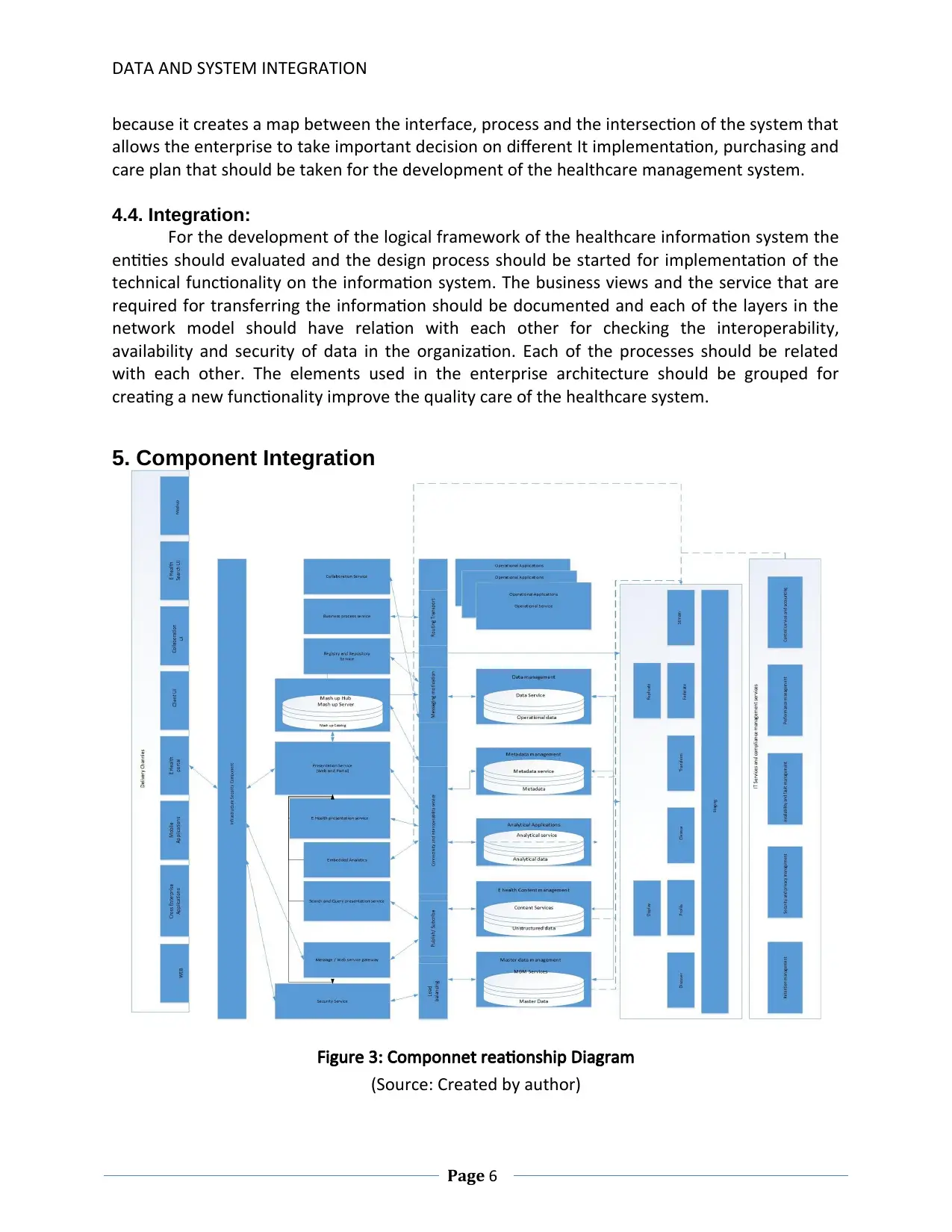
DATA AND SYSTEM INTEGRATION
because it creates a map between the interface, process and the intersection of the system that
allows the enterprise to take important decision on different It implementation, purchasing and
care plan that should be taken for the development of the healthcare management system.
4.4. Integration:
For the development of the logical framework of the healthcare information system the
entities should evaluated and the design process should be started for implementation of the
technical functionality on the information system. The business views and the service that are
required for transferring the information should be documented and each of the layers in the
network model should have relation with each other for checking the interoperability,
availability and security of data in the organization. Each of the processes should be related
with each other. The elements used in the enterprise architecture should be grouped for
creating a new functionality improve the quality care of the healthcare system.
5. Component Integration
Figure 3: Componnet reationship Diagram
(Source: Created by author)
Page 6
because it creates a map between the interface, process and the intersection of the system that
allows the enterprise to take important decision on different It implementation, purchasing and
care plan that should be taken for the development of the healthcare management system.
4.4. Integration:
For the development of the logical framework of the healthcare information system the
entities should evaluated and the design process should be started for implementation of the
technical functionality on the information system. The business views and the service that are
required for transferring the information should be documented and each of the layers in the
network model should have relation with each other for checking the interoperability,
availability and security of data in the organization. Each of the processes should be related
with each other. The elements used in the enterprise architecture should be grouped for
creating a new functionality improve the quality care of the healthcare system.
5. Component Integration
Figure 3: Componnet reationship Diagram
(Source: Created by author)
Page 6
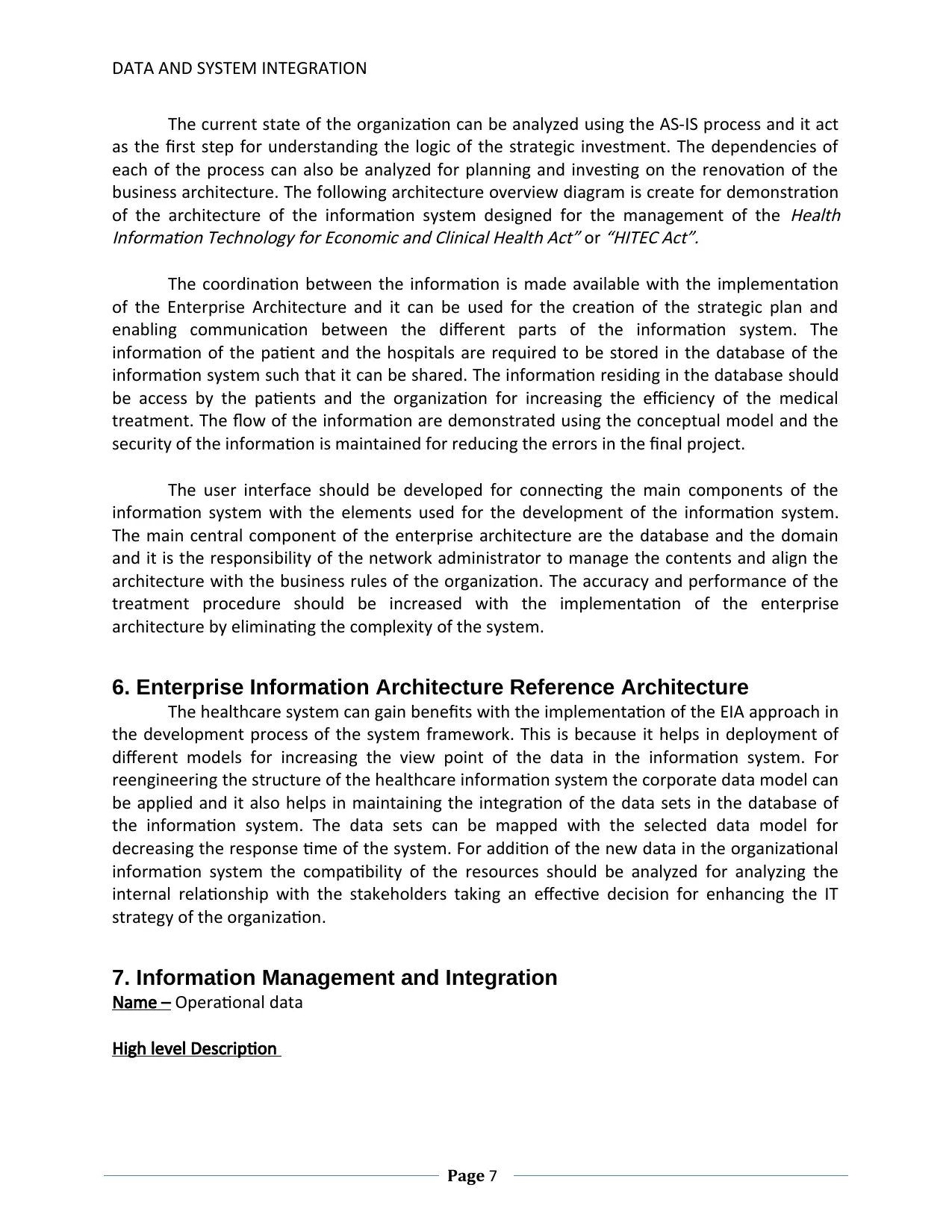
DATA AND SYSTEM INTEGRATION
The current state of the organization can be analyzed using the AS-IS process and it act
as the first step for understanding the logic of the strategic investment. The dependencies of
each of the process can also be analyzed for planning and investing on the renovation of the
business architecture. The following architecture overview diagram is create for demonstration
of the architecture of the information system designed for the management of the
Health
Information Technology for Economic and Clinical Health Act” or
“HITEC Act”.
The coordination between the information is made available with the implementation
of the Enterprise Architecture and it can be used for the creation of the strategic plan and
enabling communication between the different parts of the information system. The
information of the patient and the hospitals are required to be stored in the database of the
information system such that it can be shared. The information residing in the database should
be access by the patients and the organization for increasing the efficiency of the medical
treatment. The flow of the information are demonstrated using the conceptual model and the
security of the information is maintained for reducing the errors in the final project.
The user interface should be developed for connecting the main components of the
information system with the elements used for the development of the information system.
The main central component of the enterprise architecture are the database and the domain
and it is the responsibility of the network administrator to manage the contents and align the
architecture with the business rules of the organization. The accuracy and performance of the
treatment procedure should be increased with the implementation of the enterprise
architecture by eliminating the complexity of the system.
6. Enterprise Information Architecture Reference Architecture
The healthcare system can gain benefits with the implementation of the EIA approach in
the development process of the system framework. This is because it helps in deployment of
different models for increasing the view point of the data in the information system. For
reengineering the structure of the healthcare information system the corporate data model can
be applied and it also helps in maintaining the integration of the data sets in the database of
the information system. The data sets can be mapped with the selected data model for
decreasing the response time of the system. For addition of the new data in the organizational
information system the compatibility of the resources should be analyzed for analyzing the
internal relationship with the stakeholders taking an effective decision for enhancing the IT
strategy of the organization.
7. Information Management and Integration
Name – Operational data
High level Description
Page 7
The current state of the organization can be analyzed using the AS-IS process and it act
as the first step for understanding the logic of the strategic investment. The dependencies of
each of the process can also be analyzed for planning and investing on the renovation of the
business architecture. The following architecture overview diagram is create for demonstration
of the architecture of the information system designed for the management of the
Health
Information Technology for Economic and Clinical Health Act” or
“HITEC Act”.
The coordination between the information is made available with the implementation
of the Enterprise Architecture and it can be used for the creation of the strategic plan and
enabling communication between the different parts of the information system. The
information of the patient and the hospitals are required to be stored in the database of the
information system such that it can be shared. The information residing in the database should
be access by the patients and the organization for increasing the efficiency of the medical
treatment. The flow of the information are demonstrated using the conceptual model and the
security of the information is maintained for reducing the errors in the final project.
The user interface should be developed for connecting the main components of the
information system with the elements used for the development of the information system.
The main central component of the enterprise architecture are the database and the domain
and it is the responsibility of the network administrator to manage the contents and align the
architecture with the business rules of the organization. The accuracy and performance of the
treatment procedure should be increased with the implementation of the enterprise
architecture by eliminating the complexity of the system.
6. Enterprise Information Architecture Reference Architecture
The healthcare system can gain benefits with the implementation of the EIA approach in
the development process of the system framework. This is because it helps in deployment of
different models for increasing the view point of the data in the information system. For
reengineering the structure of the healthcare information system the corporate data model can
be applied and it also helps in maintaining the integration of the data sets in the database of
the information system. The data sets can be mapped with the selected data model for
decreasing the response time of the system. For addition of the new data in the organizational
information system the compatibility of the resources should be analyzed for analyzing the
internal relationship with the stakeholders taking an effective decision for enhancing the IT
strategy of the organization.
7. Information Management and Integration
Name – Operational data
High level Description
Page 7
⊘ This is a preview!⊘
Do you want full access?
Subscribe today to unlock all pages.

Trusted by 1+ million students worldwide
1 out of 17
Related Documents
Your All-in-One AI-Powered Toolkit for Academic Success.
+13062052269
info@desklib.com
Available 24*7 on WhatsApp / Email
![[object Object]](/_next/static/media/star-bottom.7253800d.svg)
Unlock your academic potential
Copyright © 2020–2025 A2Z Services. All Rights Reserved. Developed and managed by ZUCOL.





